Electronic Waste Management Report - BUMGT6927, Sydney, Australia
VerifiedAdded on 2023/06/04
|18
|4449
|356
Report
AI Summary
This report addresses the critical issue of electronic waste (e-waste), examining its detrimental effects on the environment, including air, water, and soil pollution. It delves into the problems associated with the rapid generation of e-waste, encompassing discarded electronic products like computers, mobile phones, and appliances. The report proposes various solutions, such as electronic recycling, waste reduction strategies, and the re-use of electronic products to mitigate the adverse impacts. Furthermore, it outlines a comprehensive implementation plan for e-waste management specifically tailored for Sydney, Australia, incorporating partnerships between NGOs and local government bodies, public awareness campaigns, and the establishment of recycling companies. The report also provides recommendations for effective and sustainable e-waste management practices, emphasizing the importance of reducing, reusing, and recycling electronic products to safeguard the environment and public health. The report includes visual aids such as mind maps and thinking hats to illustrate the e-waste management system and its various components, offering a comprehensive understanding of the topic.
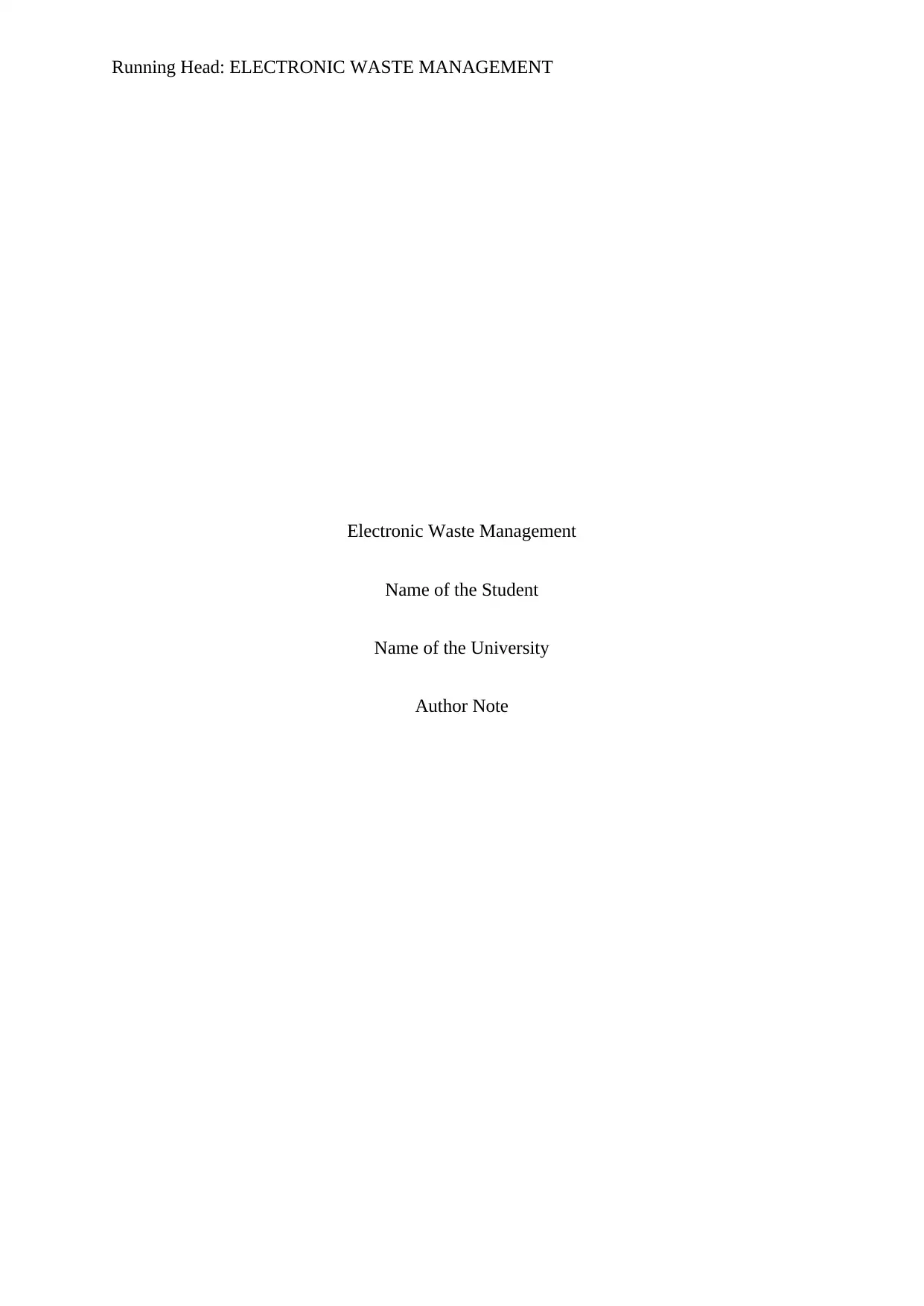
Running Head: ELECTRONIC WASTE MANAGEMENT
Electronic Waste Management
Name of the Student
Name of the University
Author Note
Electronic Waste Management
Name of the Student
Name of the University
Author Note
Paraphrase This Document
Need a fresh take? Get an instant paraphrase of this document with our AI Paraphraser
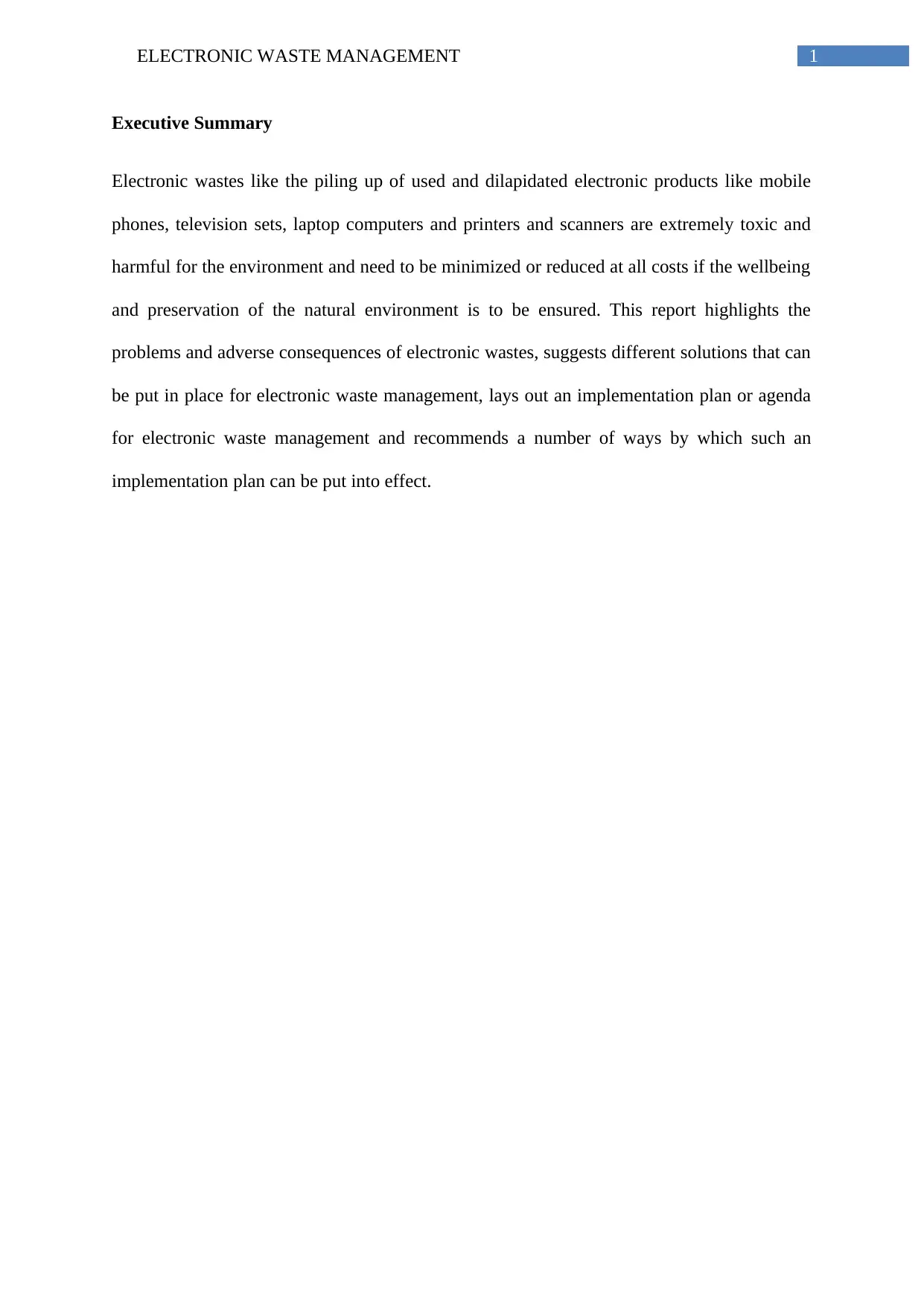
1ELECTRONIC WASTE MANAGEMENT
Executive Summary
Electronic wastes like the piling up of used and dilapidated electronic products like mobile
phones, television sets, laptop computers and printers and scanners are extremely toxic and
harmful for the environment and need to be minimized or reduced at all costs if the wellbeing
and preservation of the natural environment is to be ensured. This report highlights the
problems and adverse consequences of electronic wastes, suggests different solutions that can
be put in place for electronic waste management, lays out an implementation plan or agenda
for electronic waste management and recommends a number of ways by which such an
implementation plan can be put into effect.
Executive Summary
Electronic wastes like the piling up of used and dilapidated electronic products like mobile
phones, television sets, laptop computers and printers and scanners are extremely toxic and
harmful for the environment and need to be minimized or reduced at all costs if the wellbeing
and preservation of the natural environment is to be ensured. This report highlights the
problems and adverse consequences of electronic wastes, suggests different solutions that can
be put in place for electronic waste management, lays out an implementation plan or agenda
for electronic waste management and recommends a number of ways by which such an
implementation plan can be put into effect.
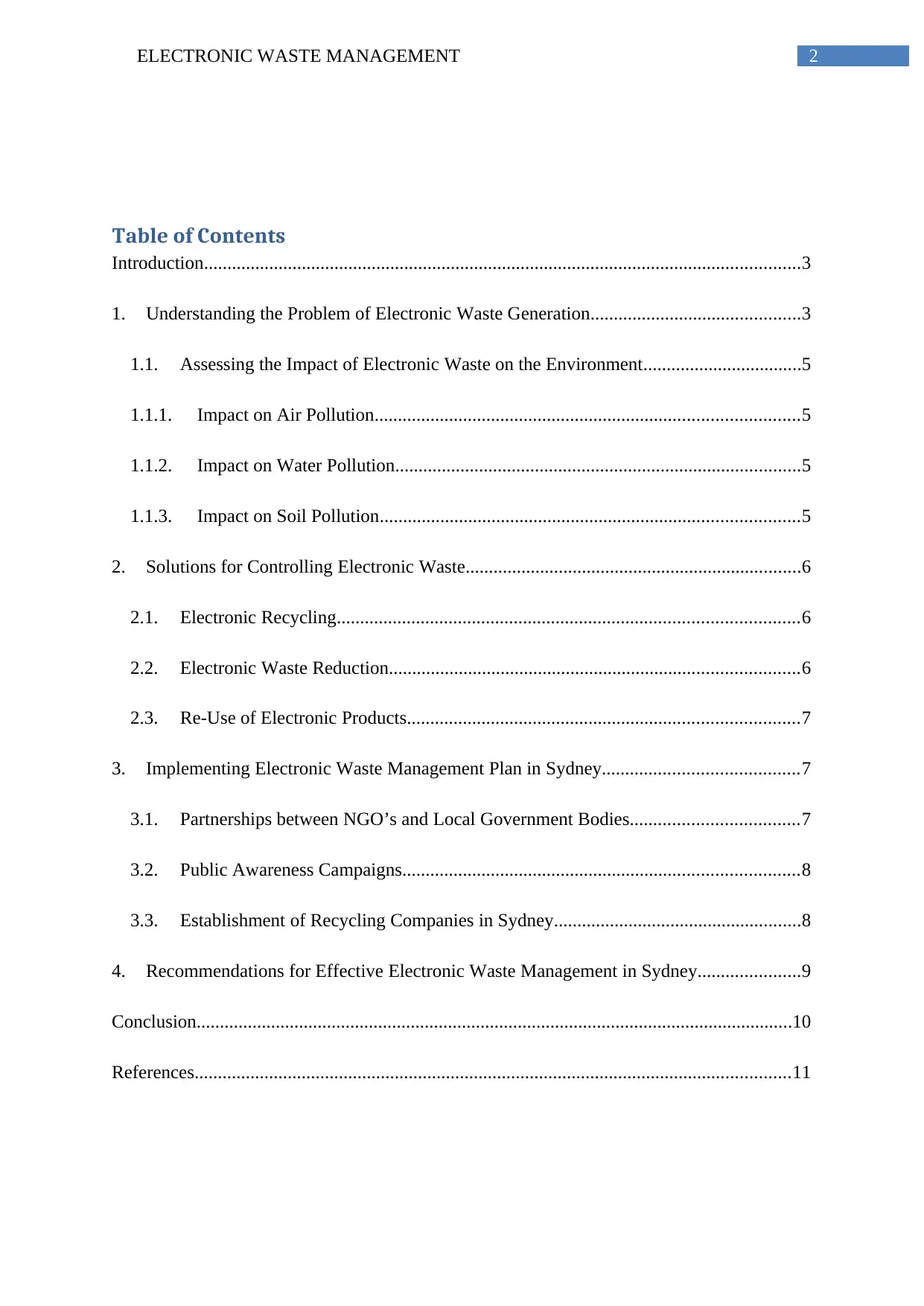
2ELECTRONIC WASTE MANAGEMENT
Table of Contents
Introduction................................................................................................................................3
1. Understanding the Problem of Electronic Waste Generation.............................................3
1.1. Assessing the Impact of Electronic Waste on the Environment..................................5
1.1.1. Impact on Air Pollution...........................................................................................5
1.1.2. Impact on Water Pollution.......................................................................................5
1.1.3. Impact on Soil Pollution..........................................................................................5
2. Solutions for Controlling Electronic Waste........................................................................6
2.1. Electronic Recycling...................................................................................................6
2.2. Electronic Waste Reduction........................................................................................6
2.3. Re-Use of Electronic Products....................................................................................7
3. Implementing Electronic Waste Management Plan in Sydney..........................................7
3.1. Partnerships between NGO’s and Local Government Bodies....................................7
3.2. Public Awareness Campaigns.....................................................................................8
3.3. Establishment of Recycling Companies in Sydney.....................................................8
4. Recommendations for Effective Electronic Waste Management in Sydney......................9
Conclusion................................................................................................................................10
References................................................................................................................................11
Table of Contents
Introduction................................................................................................................................3
1. Understanding the Problem of Electronic Waste Generation.............................................3
1.1. Assessing the Impact of Electronic Waste on the Environment..................................5
1.1.1. Impact on Air Pollution...........................................................................................5
1.1.2. Impact on Water Pollution.......................................................................................5
1.1.3. Impact on Soil Pollution..........................................................................................5
2. Solutions for Controlling Electronic Waste........................................................................6
2.1. Electronic Recycling...................................................................................................6
2.2. Electronic Waste Reduction........................................................................................6
2.3. Re-Use of Electronic Products....................................................................................7
3. Implementing Electronic Waste Management Plan in Sydney..........................................7
3.1. Partnerships between NGO’s and Local Government Bodies....................................7
3.2. Public Awareness Campaigns.....................................................................................8
3.3. Establishment of Recycling Companies in Sydney.....................................................8
4. Recommendations for Effective Electronic Waste Management in Sydney......................9
Conclusion................................................................................................................................10
References................................................................................................................................11
⊘ This is a preview!⊘
Do you want full access?
Subscribe today to unlock all pages.

Trusted by 1+ million students worldwide
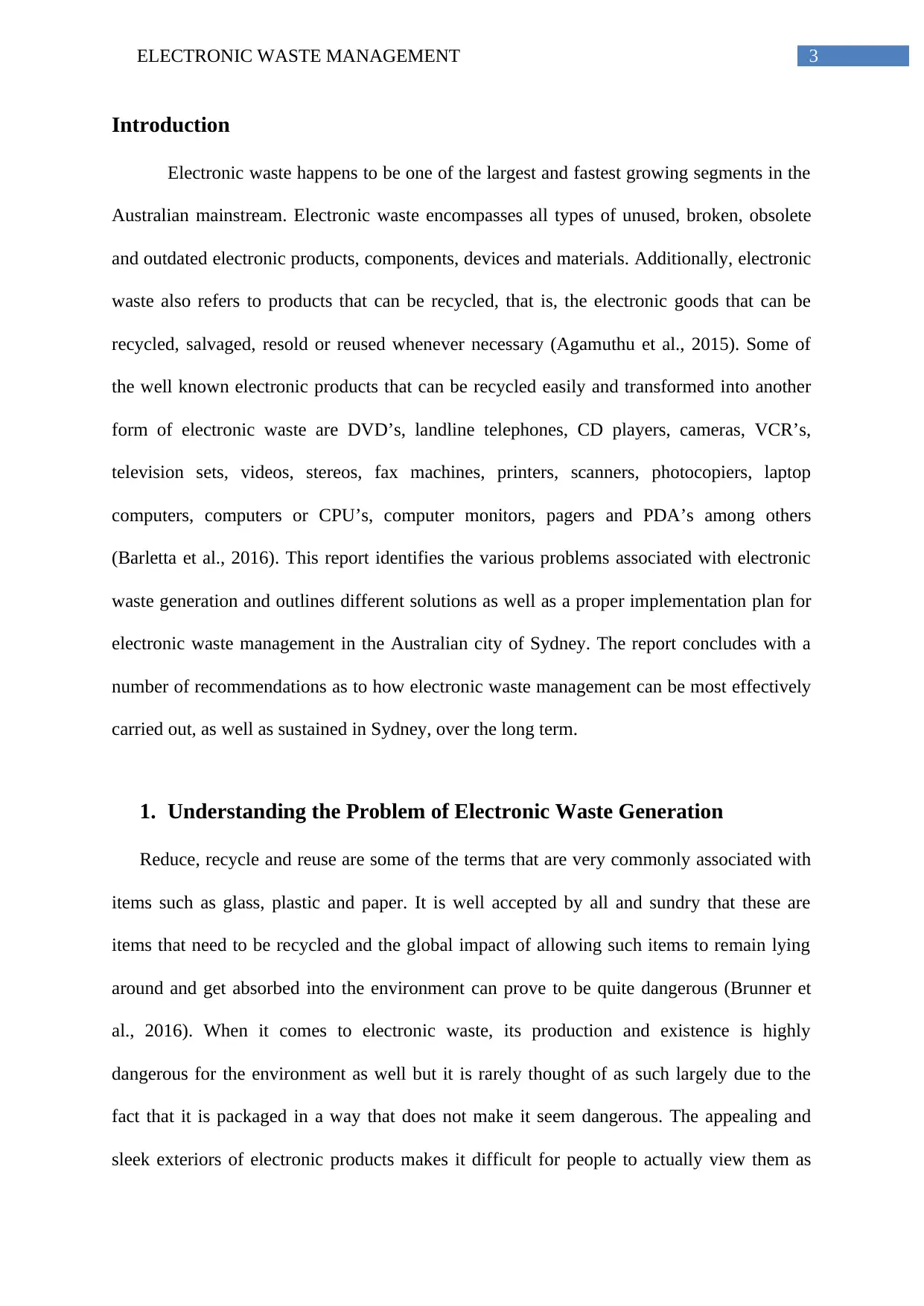
3ELECTRONIC WASTE MANAGEMENT
Introduction
Electronic waste happens to be one of the largest and fastest growing segments in the
Australian mainstream. Electronic waste encompasses all types of unused, broken, obsolete
and outdated electronic products, components, devices and materials. Additionally, electronic
waste also refers to products that can be recycled, that is, the electronic goods that can be
recycled, salvaged, resold or reused whenever necessary (Agamuthu et al., 2015). Some of
the well known electronic products that can be recycled easily and transformed into another
form of electronic waste are DVD’s, landline telephones, CD players, cameras, VCR’s,
television sets, videos, stereos, fax machines, printers, scanners, photocopiers, laptop
computers, computers or CPU’s, computer monitors, pagers and PDA’s among others
(Barletta et al., 2016). This report identifies the various problems associated with electronic
waste generation and outlines different solutions as well as a proper implementation plan for
electronic waste management in the Australian city of Sydney. The report concludes with a
number of recommendations as to how electronic waste management can be most effectively
carried out, as well as sustained in Sydney, over the long term.
1. Understanding the Problem of Electronic Waste Generation
Reduce, recycle and reuse are some of the terms that are very commonly associated with
items such as glass, plastic and paper. It is well accepted by all and sundry that these are
items that need to be recycled and the global impact of allowing such items to remain lying
around and get absorbed into the environment can prove to be quite dangerous (Brunner et
al., 2016). When it comes to electronic waste, its production and existence is highly
dangerous for the environment as well but it is rarely thought of as such largely due to the
fact that it is packaged in a way that does not make it seem dangerous. The appealing and
sleek exteriors of electronic products makes it difficult for people to actually view them as
Introduction
Electronic waste happens to be one of the largest and fastest growing segments in the
Australian mainstream. Electronic waste encompasses all types of unused, broken, obsolete
and outdated electronic products, components, devices and materials. Additionally, electronic
waste also refers to products that can be recycled, that is, the electronic goods that can be
recycled, salvaged, resold or reused whenever necessary (Agamuthu et al., 2015). Some of
the well known electronic products that can be recycled easily and transformed into another
form of electronic waste are DVD’s, landline telephones, CD players, cameras, VCR’s,
television sets, videos, stereos, fax machines, printers, scanners, photocopiers, laptop
computers, computers or CPU’s, computer monitors, pagers and PDA’s among others
(Barletta et al., 2016). This report identifies the various problems associated with electronic
waste generation and outlines different solutions as well as a proper implementation plan for
electronic waste management in the Australian city of Sydney. The report concludes with a
number of recommendations as to how electronic waste management can be most effectively
carried out, as well as sustained in Sydney, over the long term.
1. Understanding the Problem of Electronic Waste Generation
Reduce, recycle and reuse are some of the terms that are very commonly associated with
items such as glass, plastic and paper. It is well accepted by all and sundry that these are
items that need to be recycled and the global impact of allowing such items to remain lying
around and get absorbed into the environment can prove to be quite dangerous (Brunner et
al., 2016). When it comes to electronic waste, its production and existence is highly
dangerous for the environment as well but it is rarely thought of as such largely due to the
fact that it is packaged in a way that does not make it seem dangerous. The appealing and
sleek exteriors of electronic products makes it difficult for people to actually view them as
Paraphrase This Document
Need a fresh take? Get an instant paraphrase of this document with our AI Paraphraser
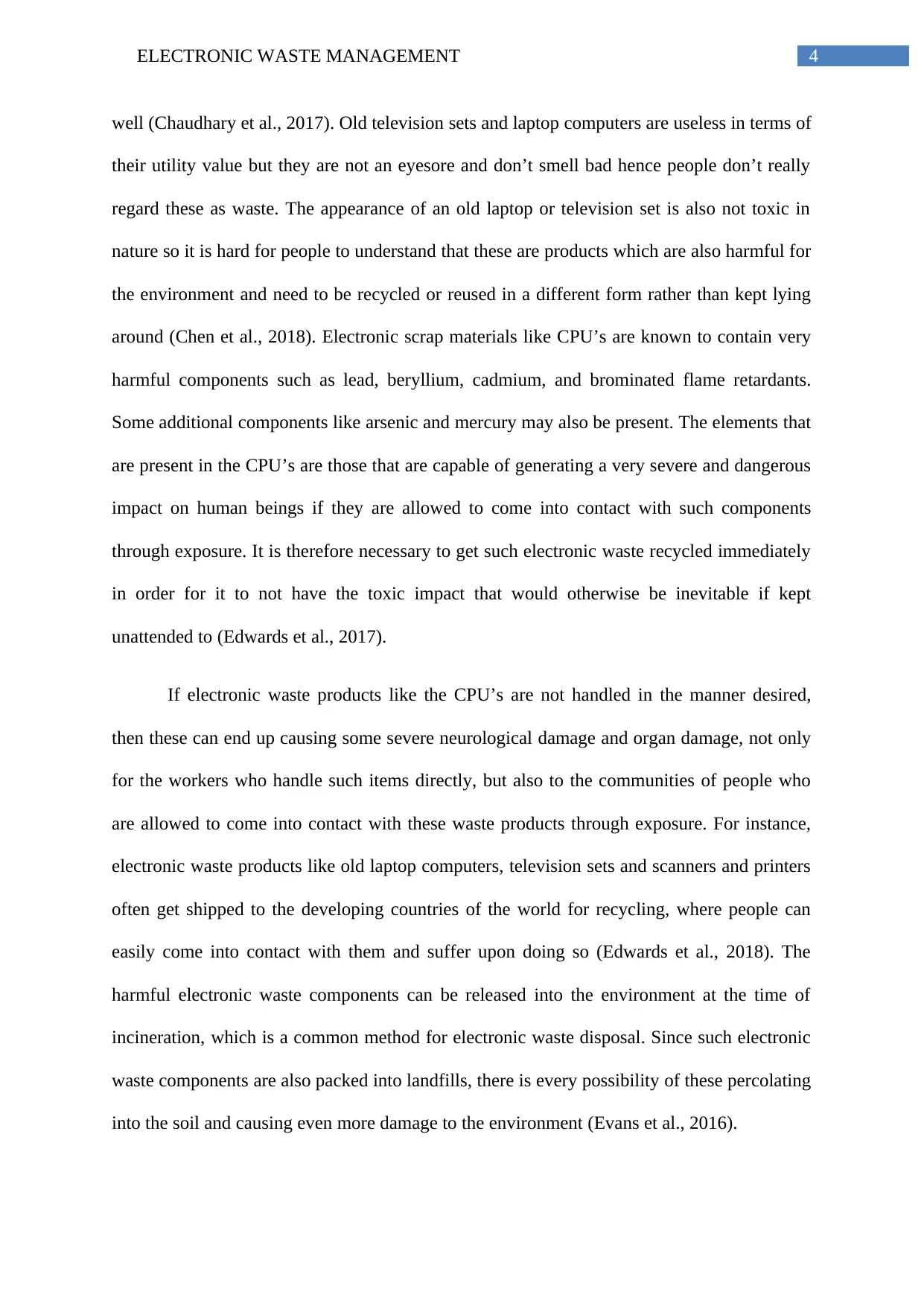
4ELECTRONIC WASTE MANAGEMENT
well (Chaudhary et al., 2017). Old television sets and laptop computers are useless in terms of
their utility value but they are not an eyesore and don’t smell bad hence people don’t really
regard these as waste. The appearance of an old laptop or television set is also not toxic in
nature so it is hard for people to understand that these are products which are also harmful for
the environment and need to be recycled or reused in a different form rather than kept lying
around (Chen et al., 2018). Electronic scrap materials like CPU’s are known to contain very
harmful components such as lead, beryllium, cadmium, and brominated flame retardants.
Some additional components like arsenic and mercury may also be present. The elements that
are present in the CPU’s are those that are capable of generating a very severe and dangerous
impact on human beings if they are allowed to come into contact with such components
through exposure. It is therefore necessary to get such electronic waste recycled immediately
in order for it to not have the toxic impact that would otherwise be inevitable if kept
unattended to (Edwards et al., 2017).
If electronic waste products like the CPU’s are not handled in the manner desired,
then these can end up causing some severe neurological damage and organ damage, not only
for the workers who handle such items directly, but also to the communities of people who
are allowed to come into contact with these waste products through exposure. For instance,
electronic waste products like old laptop computers, television sets and scanners and printers
often get shipped to the developing countries of the world for recycling, where people can
easily come into contact with them and suffer upon doing so (Edwards et al., 2018). The
harmful electronic waste components can be released into the environment at the time of
incineration, which is a common method for electronic waste disposal. Since such electronic
waste components are also packed into landfills, there is every possibility of these percolating
into the soil and causing even more damage to the environment (Evans et al., 2016).
well (Chaudhary et al., 2017). Old television sets and laptop computers are useless in terms of
their utility value but they are not an eyesore and don’t smell bad hence people don’t really
regard these as waste. The appearance of an old laptop or television set is also not toxic in
nature so it is hard for people to understand that these are products which are also harmful for
the environment and need to be recycled or reused in a different form rather than kept lying
around (Chen et al., 2018). Electronic scrap materials like CPU’s are known to contain very
harmful components such as lead, beryllium, cadmium, and brominated flame retardants.
Some additional components like arsenic and mercury may also be present. The elements that
are present in the CPU’s are those that are capable of generating a very severe and dangerous
impact on human beings if they are allowed to come into contact with such components
through exposure. It is therefore necessary to get such electronic waste recycled immediately
in order for it to not have the toxic impact that would otherwise be inevitable if kept
unattended to (Edwards et al., 2017).
If electronic waste products like the CPU’s are not handled in the manner desired,
then these can end up causing some severe neurological damage and organ damage, not only
for the workers who handle such items directly, but also to the communities of people who
are allowed to come into contact with these waste products through exposure. For instance,
electronic waste products like old laptop computers, television sets and scanners and printers
often get shipped to the developing countries of the world for recycling, where people can
easily come into contact with them and suffer upon doing so (Edwards et al., 2018). The
harmful electronic waste components can be released into the environment at the time of
incineration, which is a common method for electronic waste disposal. Since such electronic
waste components are also packed into landfills, there is every possibility of these percolating
into the soil and causing even more damage to the environment (Evans et al., 2016).
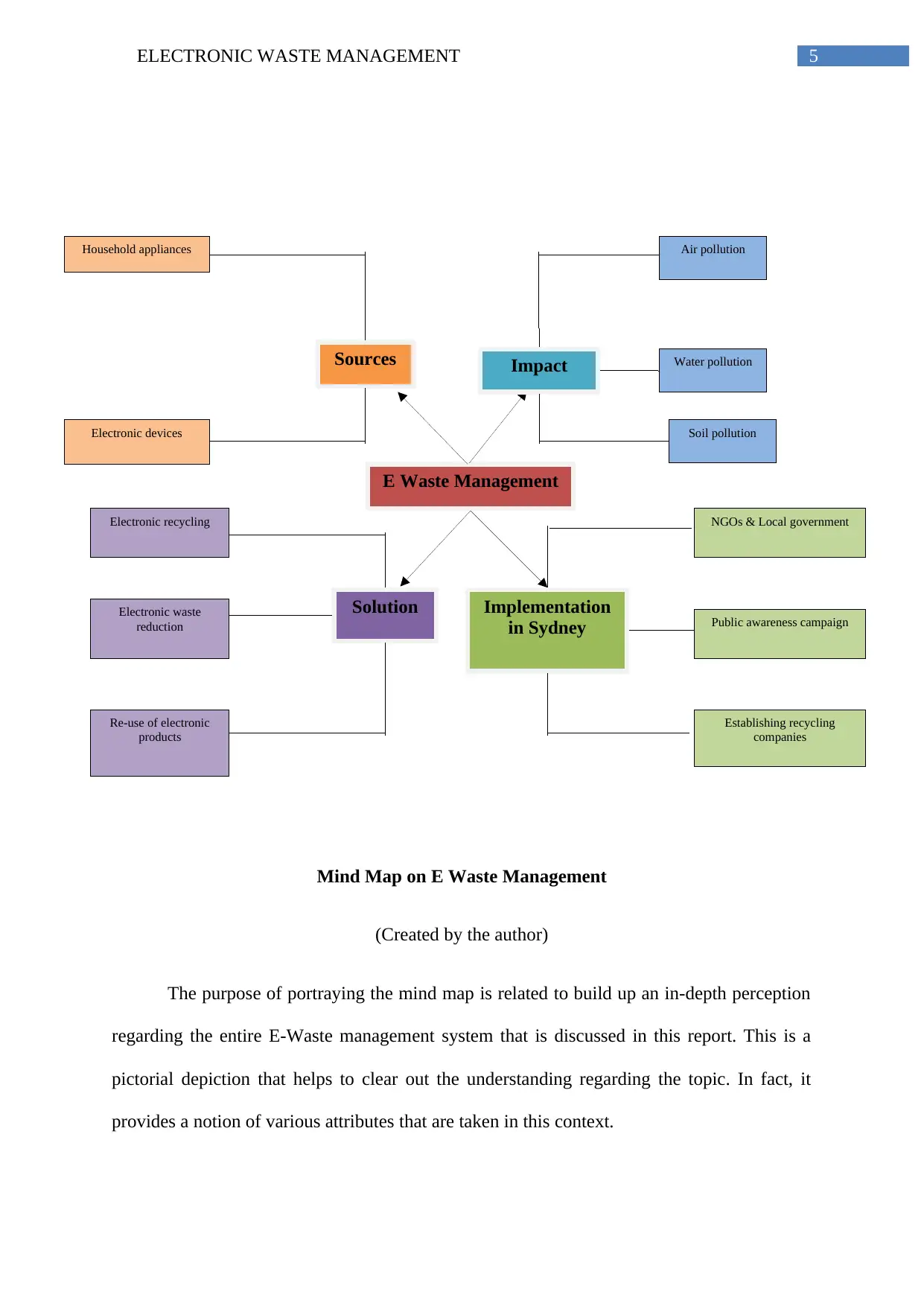
5ELECTRONIC WASTE MANAGEMENT
E Waste Management
Sources
Household appliances
Electronic devices
Impact
Air pollution
Water pollution
Soil pollution
Solution
Electronic recycling
Electronic waste
reduction
Re-use of electronic
products
Implementation
in Sydney
NGOs & Local government
Public awareness campaign
Establishing recycling
companies
Mind Map on E Waste Management
(Created by the author)
The purpose of portraying the mind map is related to build up an in-depth perception
regarding the entire E-Waste management system that is discussed in this report. This is a
pictorial depiction that helps to clear out the understanding regarding the topic. In fact, it
provides a notion of various attributes that are taken in this context.
E Waste Management
Sources
Household appliances
Electronic devices
Impact
Air pollution
Water pollution
Soil pollution
Solution
Electronic recycling
Electronic waste
reduction
Re-use of electronic
products
Implementation
in Sydney
NGOs & Local government
Public awareness campaign
Establishing recycling
companies
Mind Map on E Waste Management
(Created by the author)
The purpose of portraying the mind map is related to build up an in-depth perception
regarding the entire E-Waste management system that is discussed in this report. This is a
pictorial depiction that helps to clear out the understanding regarding the topic. In fact, it
provides a notion of various attributes that are taken in this context.
⊘ This is a preview!⊘
Do you want full access?
Subscribe today to unlock all pages.

Trusted by 1+ million students worldwide
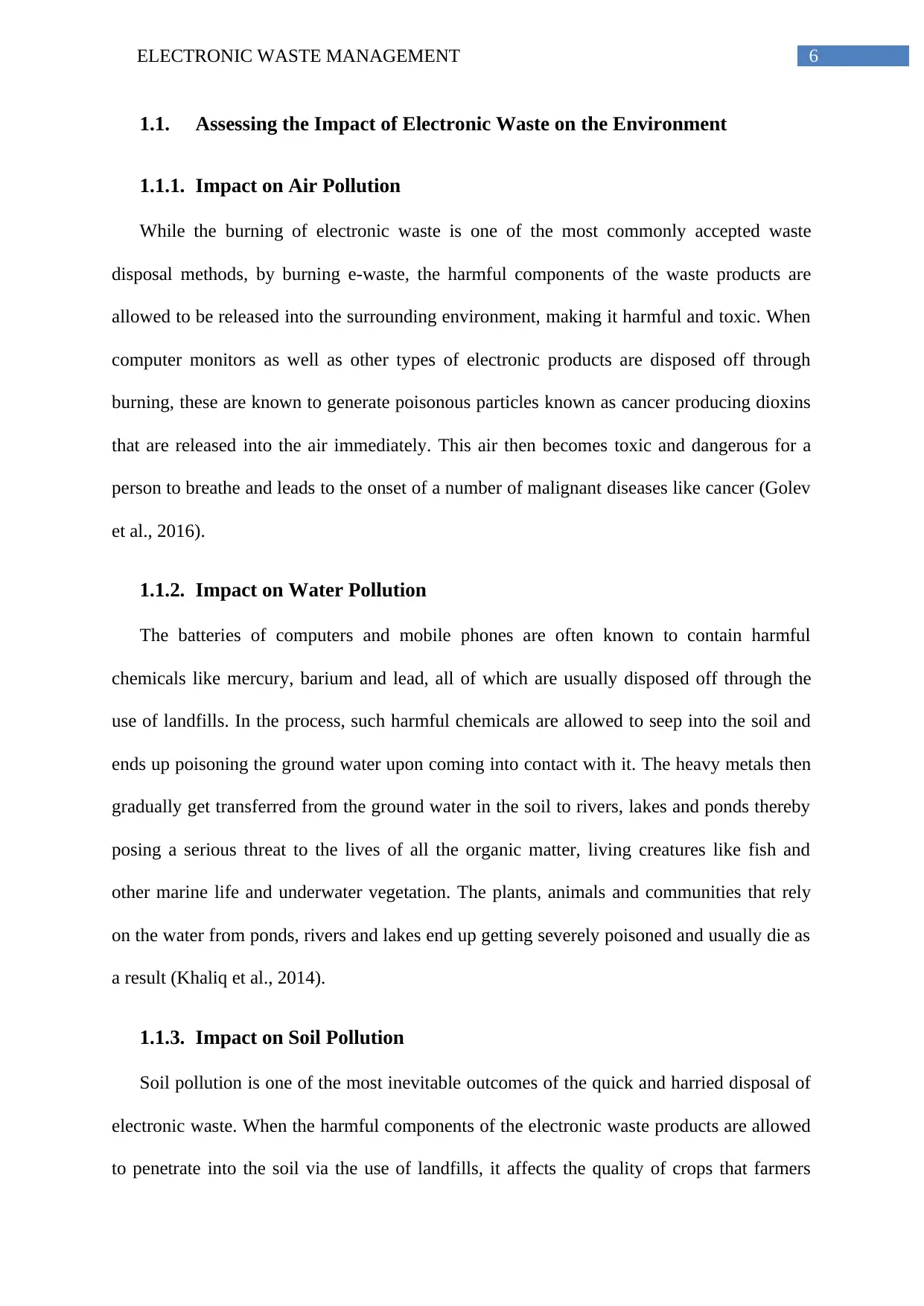
6ELECTRONIC WASTE MANAGEMENT
1.1. Assessing the Impact of Electronic Waste on the Environment
1.1.1. Impact on Air Pollution
While the burning of electronic waste is one of the most commonly accepted waste
disposal methods, by burning e-waste, the harmful components of the waste products are
allowed to be released into the surrounding environment, making it harmful and toxic. When
computer monitors as well as other types of electronic products are disposed off through
burning, these are known to generate poisonous particles known as cancer producing dioxins
that are released into the air immediately. This air then becomes toxic and dangerous for a
person to breathe and leads to the onset of a number of malignant diseases like cancer (Golev
et al., 2016).
1.1.2. Impact on Water Pollution
The batteries of computers and mobile phones are often known to contain harmful
chemicals like mercury, barium and lead, all of which are usually disposed off through the
use of landfills. In the process, such harmful chemicals are allowed to seep into the soil and
ends up poisoning the ground water upon coming into contact with it. The heavy metals then
gradually get transferred from the ground water in the soil to rivers, lakes and ponds thereby
posing a serious threat to the lives of all the organic matter, living creatures like fish and
other marine life and underwater vegetation. The plants, animals and communities that rely
on the water from ponds, rivers and lakes end up getting severely poisoned and usually die as
a result (Khaliq et al., 2014).
1.1.3. Impact on Soil Pollution
Soil pollution is one of the most inevitable outcomes of the quick and harried disposal of
electronic waste. When the harmful components of the electronic waste products are allowed
to penetrate into the soil via the use of landfills, it affects the quality of crops that farmers
1.1. Assessing the Impact of Electronic Waste on the Environment
1.1.1. Impact on Air Pollution
While the burning of electronic waste is one of the most commonly accepted waste
disposal methods, by burning e-waste, the harmful components of the waste products are
allowed to be released into the surrounding environment, making it harmful and toxic. When
computer monitors as well as other types of electronic products are disposed off through
burning, these are known to generate poisonous particles known as cancer producing dioxins
that are released into the air immediately. This air then becomes toxic and dangerous for a
person to breathe and leads to the onset of a number of malignant diseases like cancer (Golev
et al., 2016).
1.1.2. Impact on Water Pollution
The batteries of computers and mobile phones are often known to contain harmful
chemicals like mercury, barium and lead, all of which are usually disposed off through the
use of landfills. In the process, such harmful chemicals are allowed to seep into the soil and
ends up poisoning the ground water upon coming into contact with it. The heavy metals then
gradually get transferred from the ground water in the soil to rivers, lakes and ponds thereby
posing a serious threat to the lives of all the organic matter, living creatures like fish and
other marine life and underwater vegetation. The plants, animals and communities that rely
on the water from ponds, rivers and lakes end up getting severely poisoned and usually die as
a result (Khaliq et al., 2014).
1.1.3. Impact on Soil Pollution
Soil pollution is one of the most inevitable outcomes of the quick and harried disposal of
electronic waste. When the harmful components of the electronic waste products are allowed
to penetrate into the soil via the use of landfills, it affects the quality of crops that farmers
Paraphrase This Document
Need a fresh take? Get an instant paraphrase of this document with our AI Paraphraser
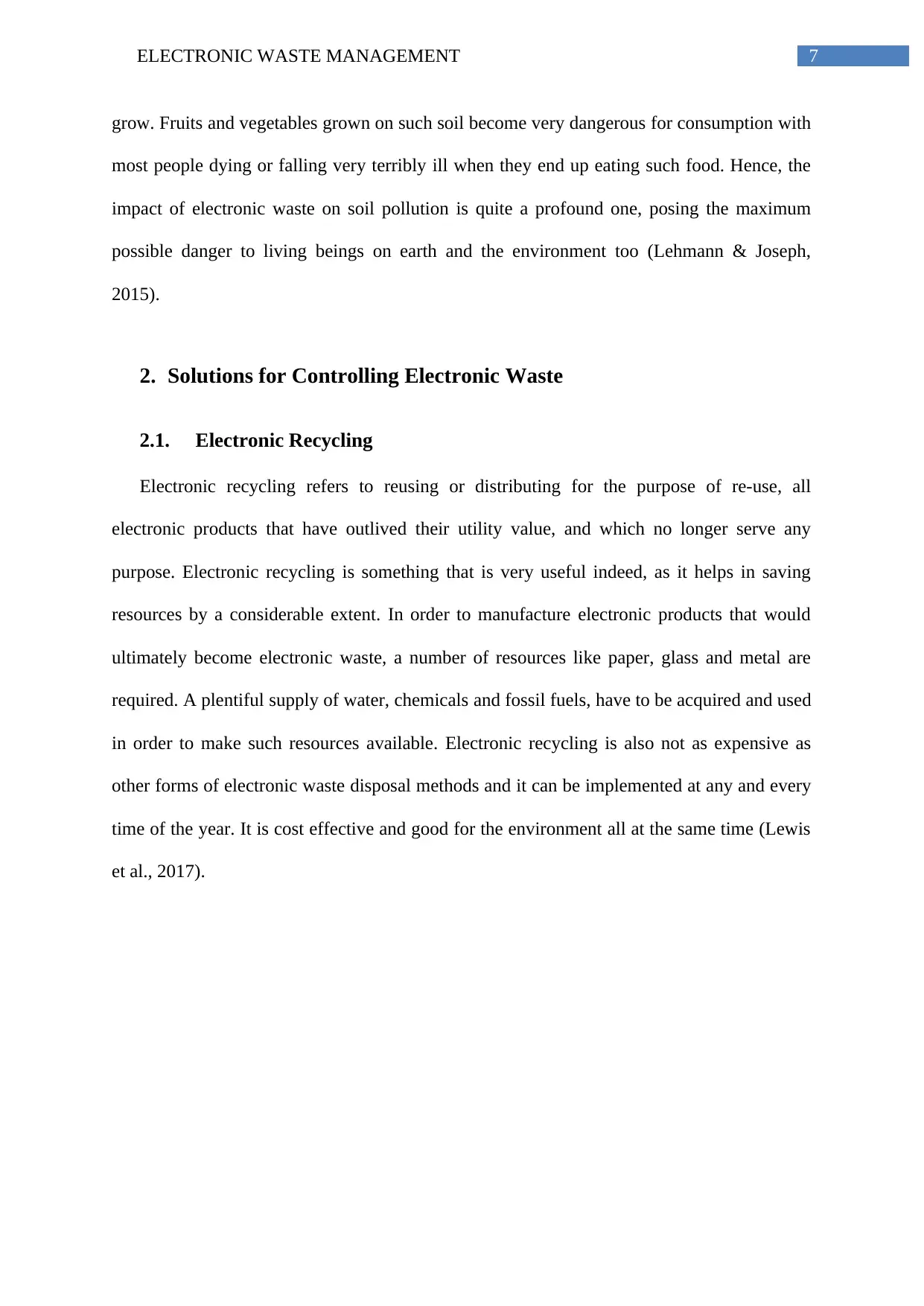
7ELECTRONIC WASTE MANAGEMENT
grow. Fruits and vegetables grown on such soil become very dangerous for consumption with
most people dying or falling very terribly ill when they end up eating such food. Hence, the
impact of electronic waste on soil pollution is quite a profound one, posing the maximum
possible danger to living beings on earth and the environment too (Lehmann & Joseph,
2015).
2. Solutions for Controlling Electronic Waste
2.1. Electronic Recycling
Electronic recycling refers to reusing or distributing for the purpose of re-use, all
electronic products that have outlived their utility value, and which no longer serve any
purpose. Electronic recycling is something that is very useful indeed, as it helps in saving
resources by a considerable extent. In order to manufacture electronic products that would
ultimately become electronic waste, a number of resources like paper, glass and metal are
required. A plentiful supply of water, chemicals and fossil fuels, have to be acquired and used
in order to make such resources available. Electronic recycling is also not as expensive as
other forms of electronic waste disposal methods and it can be implemented at any and every
time of the year. It is cost effective and good for the environment all at the same time (Lewis
et al., 2017).
grow. Fruits and vegetables grown on such soil become very dangerous for consumption with
most people dying or falling very terribly ill when they end up eating such food. Hence, the
impact of electronic waste on soil pollution is quite a profound one, posing the maximum
possible danger to living beings on earth and the environment too (Lehmann & Joseph,
2015).
2. Solutions for Controlling Electronic Waste
2.1. Electronic Recycling
Electronic recycling refers to reusing or distributing for the purpose of re-use, all
electronic products that have outlived their utility value, and which no longer serve any
purpose. Electronic recycling is something that is very useful indeed, as it helps in saving
resources by a considerable extent. In order to manufacture electronic products that would
ultimately become electronic waste, a number of resources like paper, glass and metal are
required. A plentiful supply of water, chemicals and fossil fuels, have to be acquired and used
in order to make such resources available. Electronic recycling is also not as expensive as
other forms of electronic waste disposal methods and it can be implemented at any and every
time of the year. It is cost effective and good for the environment all at the same time (Lewis
et al., 2017).
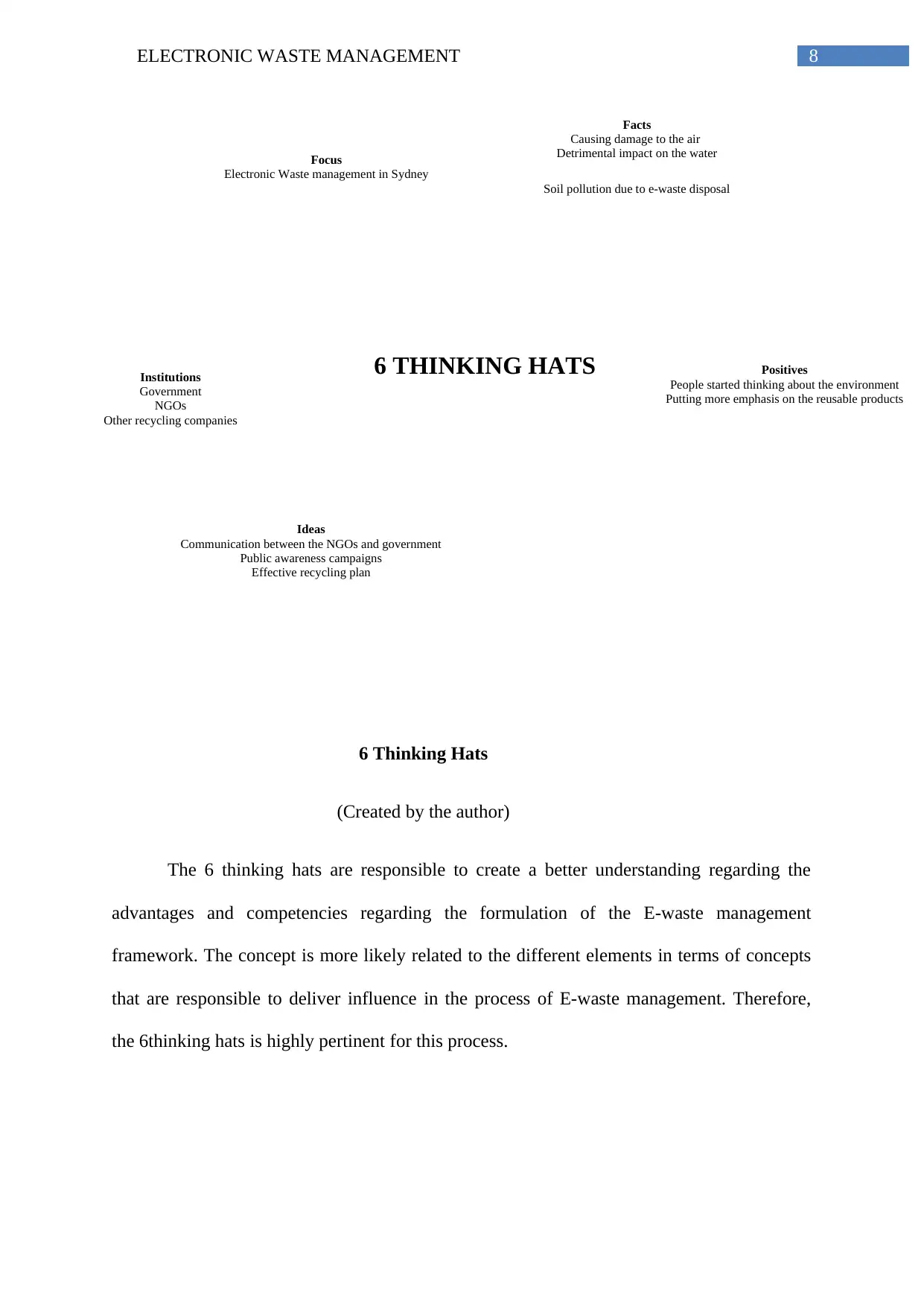
8ELECTRONIC WASTE MANAGEMENT
6 THINKING HATS
Facts
Causing damage to the air
Detrimental impact on the water
Soil pollution due to e-waste disposal
Positives
People started thinking about the environment
Putting more emphasis on the reusable products
Negatives
Lack of legal framework
Bereft of government intervention
Focus
Electronic Waste management in Sydney
Institutions
Government
NGOs
Other recycling companies
Ideas
Communication between the NGOs and government
Public awareness campaigns
Effective recycling plan
6 Thinking Hats
(Created by the author)
The 6 thinking hats are responsible to create a better understanding regarding the
advantages and competencies regarding the formulation of the E-waste management
framework. The concept is more likely related to the different elements in terms of concepts
that are responsible to deliver influence in the process of E-waste management. Therefore,
the 6thinking hats is highly pertinent for this process.
6 THINKING HATS
Facts
Causing damage to the air
Detrimental impact on the water
Soil pollution due to e-waste disposal
Positives
People started thinking about the environment
Putting more emphasis on the reusable products
Negatives
Lack of legal framework
Bereft of government intervention
Focus
Electronic Waste management in Sydney
Institutions
Government
NGOs
Other recycling companies
Ideas
Communication between the NGOs and government
Public awareness campaigns
Effective recycling plan
6 Thinking Hats
(Created by the author)
The 6 thinking hats are responsible to create a better understanding regarding the
advantages and competencies regarding the formulation of the E-waste management
framework. The concept is more likely related to the different elements in terms of concepts
that are responsible to deliver influence in the process of E-waste management. Therefore,
the 6thinking hats is highly pertinent for this process.
⊘ This is a preview!⊘
Do you want full access?
Subscribe today to unlock all pages.

Trusted by 1+ million students worldwide
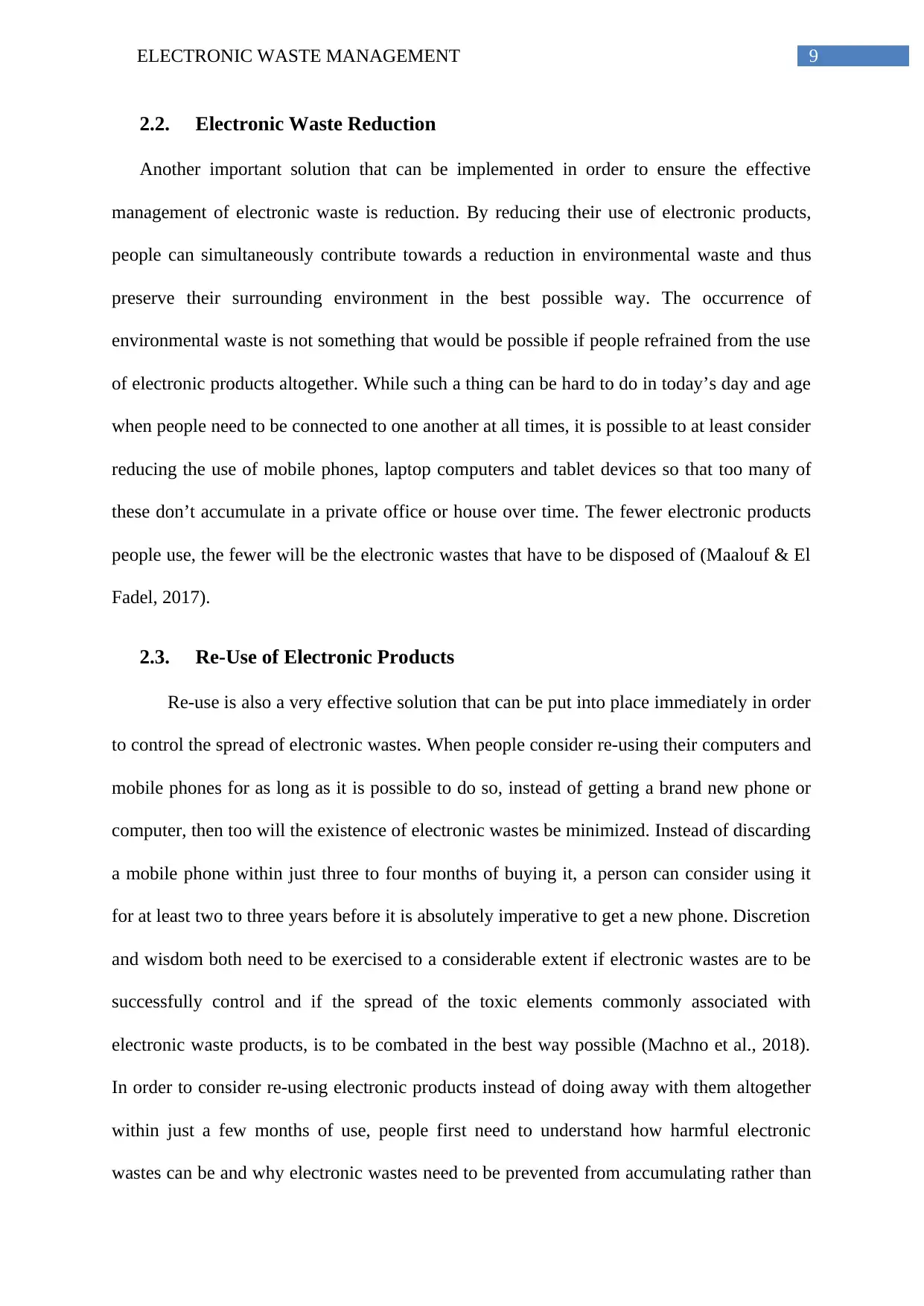
9ELECTRONIC WASTE MANAGEMENT
2.2. Electronic Waste Reduction
Another important solution that can be implemented in order to ensure the effective
management of electronic waste is reduction. By reducing their use of electronic products,
people can simultaneously contribute towards a reduction in environmental waste and thus
preserve their surrounding environment in the best possible way. The occurrence of
environmental waste is not something that would be possible if people refrained from the use
of electronic products altogether. While such a thing can be hard to do in today’s day and age
when people need to be connected to one another at all times, it is possible to at least consider
reducing the use of mobile phones, laptop computers and tablet devices so that too many of
these don’t accumulate in a private office or house over time. The fewer electronic products
people use, the fewer will be the electronic wastes that have to be disposed of (Maalouf & El
Fadel, 2017).
2.3. Re-Use of Electronic Products
Re-use is also a very effective solution that can be put into place immediately in order
to control the spread of electronic wastes. When people consider re-using their computers and
mobile phones for as long as it is possible to do so, instead of getting a brand new phone or
computer, then too will the existence of electronic wastes be minimized. Instead of discarding
a mobile phone within just three to four months of buying it, a person can consider using it
for at least two to three years before it is absolutely imperative to get a new phone. Discretion
and wisdom both need to be exercised to a considerable extent if electronic wastes are to be
successfully control and if the spread of the toxic elements commonly associated with
electronic waste products, is to be combated in the best way possible (Machno et al., 2018).
In order to consider re-using electronic products instead of doing away with them altogether
within just a few months of use, people first need to understand how harmful electronic
wastes can be and why electronic wastes need to be prevented from accumulating rather than
2.2. Electronic Waste Reduction
Another important solution that can be implemented in order to ensure the effective
management of electronic waste is reduction. By reducing their use of electronic products,
people can simultaneously contribute towards a reduction in environmental waste and thus
preserve their surrounding environment in the best possible way. The occurrence of
environmental waste is not something that would be possible if people refrained from the use
of electronic products altogether. While such a thing can be hard to do in today’s day and age
when people need to be connected to one another at all times, it is possible to at least consider
reducing the use of mobile phones, laptop computers and tablet devices so that too many of
these don’t accumulate in a private office or house over time. The fewer electronic products
people use, the fewer will be the electronic wastes that have to be disposed of (Maalouf & El
Fadel, 2017).
2.3. Re-Use of Electronic Products
Re-use is also a very effective solution that can be put into place immediately in order
to control the spread of electronic wastes. When people consider re-using their computers and
mobile phones for as long as it is possible to do so, instead of getting a brand new phone or
computer, then too will the existence of electronic wastes be minimized. Instead of discarding
a mobile phone within just three to four months of buying it, a person can consider using it
for at least two to three years before it is absolutely imperative to get a new phone. Discretion
and wisdom both need to be exercised to a considerable extent if electronic wastes are to be
successfully control and if the spread of the toxic elements commonly associated with
electronic waste products, is to be combated in the best way possible (Machno et al., 2018).
In order to consider re-using electronic products instead of doing away with them altogether
within just a few months of use, people first need to understand how harmful electronic
wastes can be and why electronic wastes need to be prevented from accumulating rather than
Paraphrase This Document
Need a fresh take? Get an instant paraphrase of this document with our AI Paraphraser
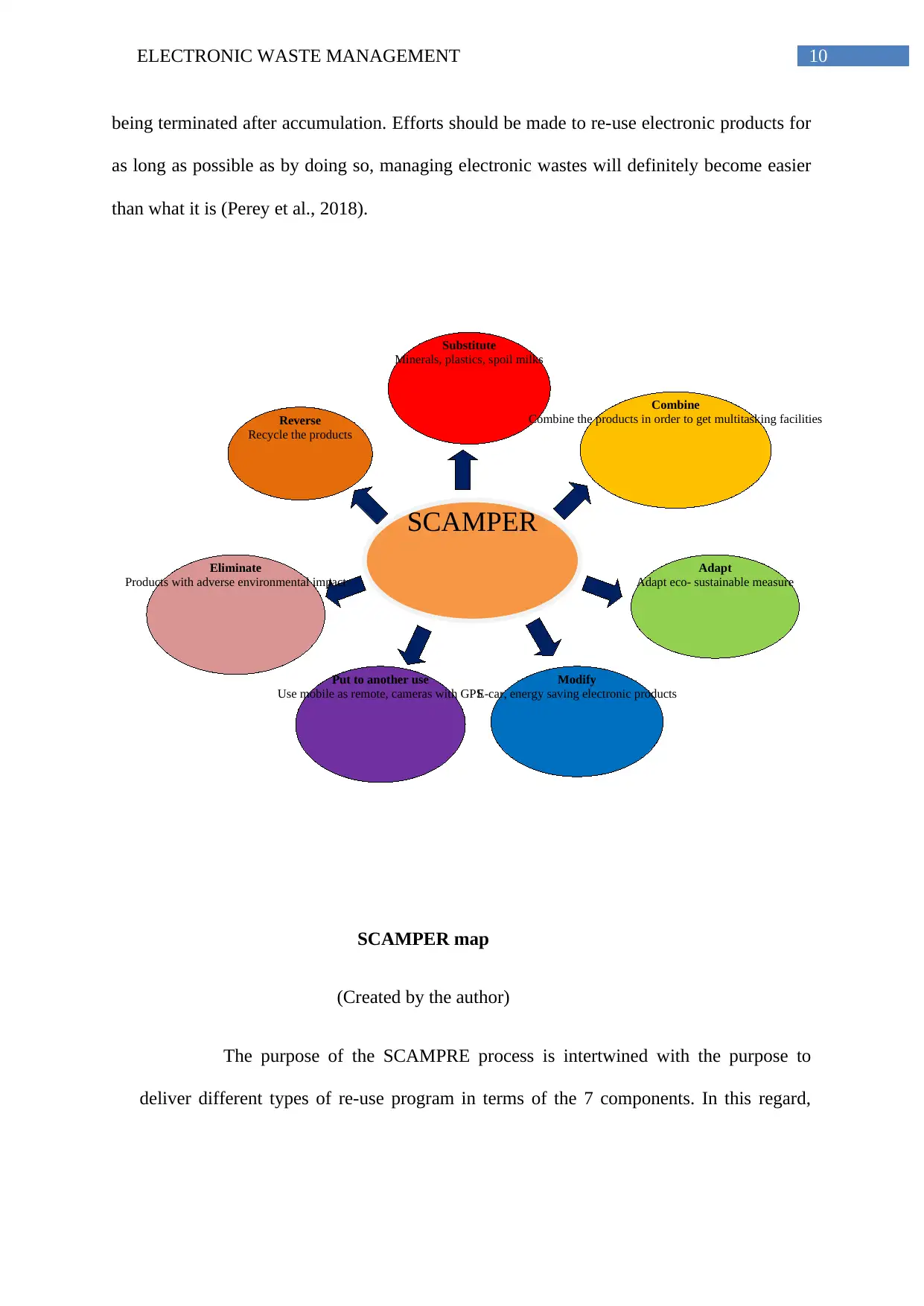
10ELECTRONIC WASTE MANAGEMENT
SCAMPER
Substitute
Minerals, plastics, spoil milks
Combine
Combine the products in order to get multitasking facilities
Put to another use
Use mobile as remote, cameras with GPS
Eliminate
Products with adverse environmental impact
Reverse
Recycle the products
Modify
E-car, energy saving electronic products
Adapt
Adapt eco- sustainable measure
being terminated after accumulation. Efforts should be made to re-use electronic products for
as long as possible as by doing so, managing electronic wastes will definitely become easier
than what it is (Perey et al., 2018).
SCAMPER map
(Created by the author)
The purpose of the SCAMPRE process is intertwined with the purpose to
deliver different types of re-use program in terms of the 7 components. In this regard,
SCAMPER
Substitute
Minerals, plastics, spoil milks
Combine
Combine the products in order to get multitasking facilities
Put to another use
Use mobile as remote, cameras with GPS
Eliminate
Products with adverse environmental impact
Reverse
Recycle the products
Modify
E-car, energy saving electronic products
Adapt
Adapt eco- sustainable measure
being terminated after accumulation. Efforts should be made to re-use electronic products for
as long as possible as by doing so, managing electronic wastes will definitely become easier
than what it is (Perey et al., 2018).
SCAMPER map
(Created by the author)
The purpose of the SCAMPRE process is intertwined with the purpose to
deliver different types of re-use program in terms of the 7 components. In this regard,
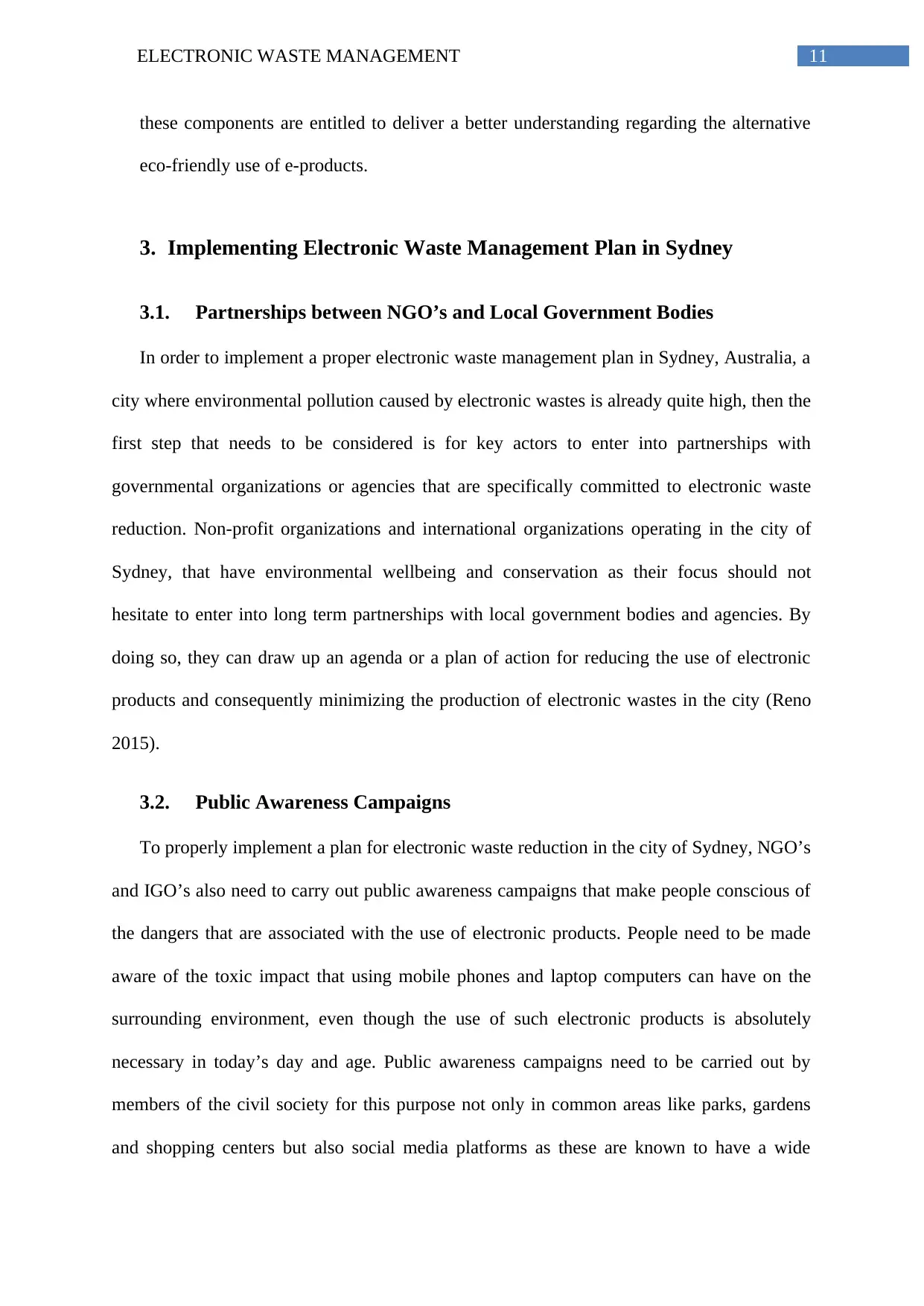
11ELECTRONIC WASTE MANAGEMENT
these components are entitled to deliver a better understanding regarding the alternative
eco-friendly use of e-products.
3. Implementing Electronic Waste Management Plan in Sydney
3.1. Partnerships between NGO’s and Local Government Bodies
In order to implement a proper electronic waste management plan in Sydney, Australia, a
city where environmental pollution caused by electronic wastes is already quite high, then the
first step that needs to be considered is for key actors to enter into partnerships with
governmental organizations or agencies that are specifically committed to electronic waste
reduction. Non-profit organizations and international organizations operating in the city of
Sydney, that have environmental wellbeing and conservation as their focus should not
hesitate to enter into long term partnerships with local government bodies and agencies. By
doing so, they can draw up an agenda or a plan of action for reducing the use of electronic
products and consequently minimizing the production of electronic wastes in the city (Reno
2015).
3.2. Public Awareness Campaigns
To properly implement a plan for electronic waste reduction in the city of Sydney, NGO’s
and IGO’s also need to carry out public awareness campaigns that make people conscious of
the dangers that are associated with the use of electronic products. People need to be made
aware of the toxic impact that using mobile phones and laptop computers can have on the
surrounding environment, even though the use of such electronic products is absolutely
necessary in today’s day and age. Public awareness campaigns need to be carried out by
members of the civil society for this purpose not only in common areas like parks, gardens
and shopping centers but also social media platforms as these are known to have a wide
these components are entitled to deliver a better understanding regarding the alternative
eco-friendly use of e-products.
3. Implementing Electronic Waste Management Plan in Sydney
3.1. Partnerships between NGO’s and Local Government Bodies
In order to implement a proper electronic waste management plan in Sydney, Australia, a
city where environmental pollution caused by electronic wastes is already quite high, then the
first step that needs to be considered is for key actors to enter into partnerships with
governmental organizations or agencies that are specifically committed to electronic waste
reduction. Non-profit organizations and international organizations operating in the city of
Sydney, that have environmental wellbeing and conservation as their focus should not
hesitate to enter into long term partnerships with local government bodies and agencies. By
doing so, they can draw up an agenda or a plan of action for reducing the use of electronic
products and consequently minimizing the production of electronic wastes in the city (Reno
2015).
3.2. Public Awareness Campaigns
To properly implement a plan for electronic waste reduction in the city of Sydney, NGO’s
and IGO’s also need to carry out public awareness campaigns that make people conscious of
the dangers that are associated with the use of electronic products. People need to be made
aware of the toxic impact that using mobile phones and laptop computers can have on the
surrounding environment, even though the use of such electronic products is absolutely
necessary in today’s day and age. Public awareness campaigns need to be carried out by
members of the civil society for this purpose not only in common areas like parks, gardens
and shopping centers but also social media platforms as these are known to have a wide
⊘ This is a preview!⊘
Do you want full access?
Subscribe today to unlock all pages.

Trusted by 1+ million students worldwide
1 out of 18
Related Documents
Your All-in-One AI-Powered Toolkit for Academic Success.
+13062052269
info@desklib.com
Available 24*7 on WhatsApp / Email
![[object Object]](/_next/static/media/star-bottom.7253800d.svg)
Unlock your academic potential
Copyright © 2020–2025 A2Z Services. All Rights Reserved. Developed and managed by ZUCOL.





